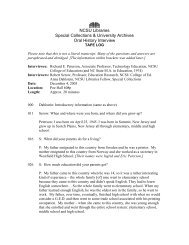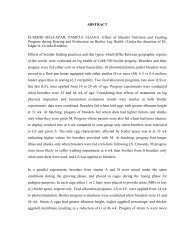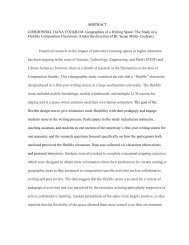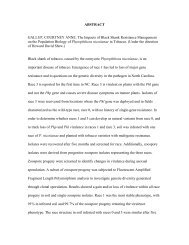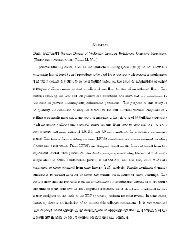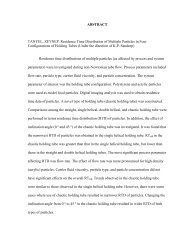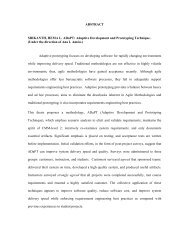SMITH, CHRISTINA JEAN. What Disappears and What Remains
SMITH, CHRISTINA JEAN. What Disappears and What Remains
SMITH, CHRISTINA JEAN. What Disappears and What Remains
Create successful ePaper yourself
Turn your PDF publications into a flip-book with our unique Google optimized e-Paper software.
This <strong>and</strong>rocentric <strong>and</strong> largely fruitless l<strong>and</strong>scape (for there are very few children aswell) is reflective of Miller’s <strong>and</strong> his generation's pessimism in regards to the postapocalypticpossibilities, their fears about what a post-apocalyptic l<strong>and</strong>scape would look like(mutants, aberrations of nature) <strong>and</strong> of the marginal place that women would occupy in thisworld. By hiding but not completely hiding the women in his world <strong>and</strong> by striking those wedo see with disfigurements or injuries - Miller makes the point that women (<strong>and</strong> by extensionchildren <strong>and</strong> the family unit) will not be safe in a post-apocalyptic world. 10Post-Apocalypse ObjectsIf his decision to underline the deterministic techno-primitive cycle <strong>and</strong> to cut women out ofthe narrative point strongly toward Miller's negative view of the post-atomic possibilities,then the ways in which post-apocalypse relics (<strong>and</strong>, specifically, the Leibowitzian blueprint)are regarded <strong>and</strong> utilized show a more open-ended view on Miller's part. He uses theseobjects to highlight man's potential for innocence <strong>and</strong> goodness <strong>and</strong> to provide his readerwith an objective vantage point from which they may view the events of Canticle (a vantagepoint that Miller, fatalistic as he is, surely hopes his reader will use to underst<strong>and</strong> the lessonsCanticle has to offer <strong>and</strong> to avoid the fate of its fictional inhabitants).Miller roots his positive view of humanity in Canticle's "novice". Francis is "new" inevery sense of the word. He is young (approximately 17 years of age), impressionable but,10 Because of his near complete exclusion of women in the text, Miller also manages to avoid the subject of sexual violence<strong>and</strong> predation with which many of the writers who follow him will deal. In all of his portrayals of male violence in Canticle(the men rob, shoot <strong>and</strong> eat one another <strong>and</strong> wage wars), Miller never directly examines how that violence <strong>and</strong> socialdisorder might have affected the women <strong>and</strong> children of Fiat Homo <strong>and</strong> Fiat Lux (periods which correspond with our ownMiddle Ages <strong>and</strong> Renaissance, respectively). Certainly the idea that women <strong>and</strong> children could be the victims of rape <strong>and</strong>violence in this type of world occurred to Miller <strong>and</strong>, yet, instead of exploring the effect that a sudden <strong>and</strong> catastrophicdissolution of modern society would have on men <strong>and</strong> women's familial <strong>and</strong> sexual interactions with one another, Millernearly pushes women <strong>and</strong> children out of the world altogether by rooting his story in the walls of an abbey. This could beout of respect for his 1950s era audience, which might have been uncomfortable with allusions to rape or incest, or becauseadventure <strong>and</strong> science fiction novels during this time were told largely from a male point of view.19



